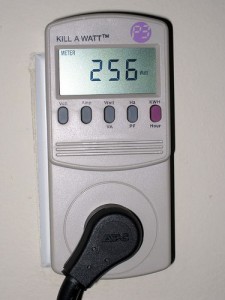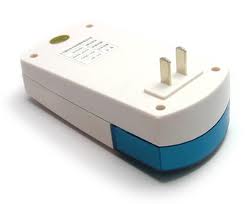This coming weekend marks the annual Earth Hour awareness campaign. It’s that time of the year again when we’re reminded of the growing toll our energy expenditure takes on the planet. But energy conservation isn’t just for tree-hugging environmentalists and people who just want to jump in the conservation bandwagon because it’s the “in” thing. Far from it, energy conservation should be on every Filipino’s minds because it not only impacts our planet, but our wallets as well.
As everyone should be aware by now, the Philippines has the dubious honor of having one of the most exorbitant utility rates in the world. Blame it on the monopoly, the inefficient power generation and distribution system, or the rampant energy theft… but in the end, we just have to grin and bear it.
So what’s poor Juan to do? Solar power? pedal-powered generators? Nothing quite so dramatic. Just a few simple changes in the way we use our appliances can make all the difference.
What was that? You thought Earth Day was just about shutting down the lights for a few minutes? That’s just to get your attention, my friend. If that’s all you did for Earth Day, then the real message didn’t get through to you. So time to make a few changes in your household and be a pal for Mother Earth? But what’s in it for you? Besides doing your part in reducing your carbon footprint, you can save a whole lot in your monthly electricity bill as well, making your wallet very happy. So its a win-win situation for everyone. So let’s get cracking…
 For a while now, we’ve been conducting energy awareness campaigns in our local neighborhood, and offices around the area. A lot of people today are still woefully unaware just how much their appliances are costing them. We use a digital watt-meter capable of measuring the actual wattage of real-world appliances in actual use to get the most accurate picture of the energy expenditure each electrical device in your house actually costs to run. This way, we don’t rely on the labels and brochures that sometimes show misleading figures when it comes to actual electrical consumption. Another problem we point out is the issue of vampire-drain: appliances that continue to suck electricity in standby mode even when you think it’s already off. You’d be surprised at how some of your appliances draw as much power as an open light when you think you already shut it down.
For a while now, we’ve been conducting energy awareness campaigns in our local neighborhood, and offices around the area. A lot of people today are still woefully unaware just how much their appliances are costing them. We use a digital watt-meter capable of measuring the actual wattage of real-world appliances in actual use to get the most accurate picture of the energy expenditure each electrical device in your house actually costs to run. This way, we don’t rely on the labels and brochures that sometimes show misleading figures when it comes to actual electrical consumption. Another problem we point out is the issue of vampire-drain: appliances that continue to suck electricity in standby mode even when you think it’s already off. You’d be surprised at how some of your appliances draw as much power as an open light when you think you already shut it down.
.
Tech Talk
.
First off, let’s talk about computers. Is your current system a good fit for what you use it for? If all you do is word-processing or surf the net, you’re better off with a laptop or netbook.
Computers
Low-end netbook – 15 watts
Mid-range laptop – 30 watts
Low-end desktop (no videocard) – 40 watts
Mid-range desktop (2-core, cheap videocard) – 150-200 watts
High-end desktop (4-core, premium videocard) – 150-400 watts
The good news is, most computers nowadays are capable of automatically adjusting their energy consumption according to actual usage, that is, it powers down if you’re just typing a report and cranks up the juice only when you’re doing something graphics-intensive like playing a game or watching an HD movie (thus the range I indicated in the mid-to-high end systems). But still, there is a minimum overhead and it’s still highly inefficient to use your souped-up high-end system just to surf the web as it still uses 5 times more power than a regular laptop at its lowest operational mode.
Screens
CRT monitor – 40 watts
LED monitor – 15 watts
If you’re still using a CRT monitor, you might want to replace it with an LED version. If you use your computer the whole day, the energy savings you get by using an LED monitor will eventually add up and pay for itself.
Other things to watch out for:
Desktop PC (turned off but still plugged) – 3 watts
Desktop speakers (turned on but no sound) – 10 watts
Do unplug your computer and speakers after use. They drain power even when idle. If you’re using a laptop and it’s always in one place, consider taking out the battery pack altogether and run it straight from the plug. The constant battery charging also wastes a lot of power. Current battery technology is still highly inefficient. It slowly loses its charge when not in use, and the power used to charge it compared to the actual power you can later squeeze out of it still leaves a lot to be desired. Watch out for gadgets that have a power-brick or AC-DC transformer. Those things continue to drain minimal power from the tap even if the equipment’s off. If you feel the brick with your hands, it’s warm to the touch even though you’ve turned off the power. Better to unplug those or use a multi-adapter that has its own power switch.
Entertainment:
CRT TV (14″) – 60 watts
LCD TV (14″) – 15 watts
CRT TV (32″) – 110 watts
.
Other things to watch out for:
CRT TV (standby) – 7 watts
LCD TV (standby) – 2 watts
Cable digibox (standby) – 6 watts
.
Some Like it Hot, Some Like it Cold…
Cooling:
Electric fan – 50-60 watts
Ref (small) – 120 watts
Aircon (small) – 800 watts
Heating:
Coffee maker – 800 watts
Toaster – 1000 watts
Iron – 1200 watts
Here we see that the big-ticket items when it comes to energy expenditure are heating and cooling. This is where you’d want to concentrate on if you want to see big savings in your next electricity bill. You might want to pass on using the water heater for the shower during summer and leaving the air conditioner on the whole night during the cooler months. Cooking using LPG instead of electrical appliances will also net you big savings.
.
Energy-saving Gimmicks
.
What about those energy-saving gadgets you see in the mall? Do they really work?
 We bought one of those power-savers and tested it out at home. Since it’s a capacitor array and is supposed to work best for appliances with a motor or compressor, we tried it out on just those appliances. The digital read-out of our before-and-after comparison shows a whopping savings of 1 watt on the 60 watt electric fan we tried it on. A far cry from the 30-40% energy savings being advertised but at least it actually works… kinda. The thing is, the engineers who designed most of our appliances already tweaked them to work as efficiently as possible. If all it takes to boost its efficiency by 40% is to add a few more capacitors, don’t you think the manufacturers would have thought of it by now? I have no idea what kind of clunky motor they use in the store demos but it sure as hell ain’t the ones you’d buy for your home. Sure, you could probably see a bit more dramatic results if you’re using it on an old antique appliance from the 1980’s… but don’t you think its better to just upgrade to a newer, more efficient model rather than buying a gadget that costs more than a thousand bucks on its own?
We bought one of those power-savers and tested it out at home. Since it’s a capacitor array and is supposed to work best for appliances with a motor or compressor, we tried it out on just those appliances. The digital read-out of our before-and-after comparison shows a whopping savings of 1 watt on the 60 watt electric fan we tried it on. A far cry from the 30-40% energy savings being advertised but at least it actually works… kinda. The thing is, the engineers who designed most of our appliances already tweaked them to work as efficiently as possible. If all it takes to boost its efficiency by 40% is to add a few more capacitors, don’t you think the manufacturers would have thought of it by now? I have no idea what kind of clunky motor they use in the store demos but it sure as hell ain’t the ones you’d buy for your home. Sure, you could probably see a bit more dramatic results if you’re using it on an old antique appliance from the 1980’s… but don’t you think its better to just upgrade to a newer, more efficient model rather than buying a gadget that costs more than a thousand bucks on its own?
What about those new Inverter-type air-conditioners? Those are the real deal. They do work 20-30% more efficiently than their regular counterparts. If your office or home is air-conditioned most of the day and you can install a split-type unit without any major reconstruction, go for it. It’s a bit more expensive but the price difference will pay for itself given our horrendous local electricity rates.
Now these are just a few tips on how to reduce your monthly bills, you could probably find a bit more useful tips if you scour the Net. A little bit of know-how goes a long way in the road to energy conservation. So if you have your own bits of good advice you’d like to share, do post a comment and let other people know how they can save both the environment and their hard-earned cash.




I don’t usually reply to posts but I will in this case. WoW
Hello! kbeckfa interesting kbeckfa site!
Thanks for giving your ideas listed here. The other thing is that whenever a problem appears with a laptop or computer motherboard, individuals should not consider the risk regarding repairing the item themselves because if it is not done right it can lead to irreparable damage to the whole laptop. It is usually safe just to approach a dealer of your laptop for the repair of that motherboard. They've technicians who've an experience in dealing with notebook computer motherboard challenges and can carry out the right analysis and carry out repairs.
[…] they are “in” thing. Far from it, energy conservation should be on any … Read Filipino freethinkers Mobile Group Creates the in-field computing L? sung with the GD8000 Rugged Laptop Group Mobile, […]
electricity is evil – Amish
imagine if the Amish were the one to get a theocratic hold on the Philippines 🙂 we'd be fighting for the use of electricity instead of contraceptives, hehe
Great Wes! How much does the digital watt meter cost and where can i get one?
You can find those in Ace Hardware in SM in the electrical equipment section beside the voltage regulators and rechargeable batteries. Omni's model is around 900 bucks if I remember correctly, and goes up until 1Amp max.
Wow, excellent post! I hope this information really gets around, so people do more than just jump on the turn-off-your-lights-for-an-hour bandwagon.